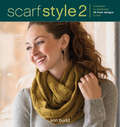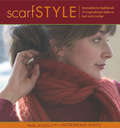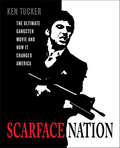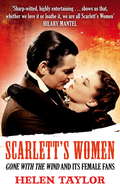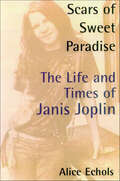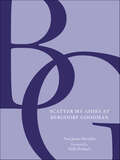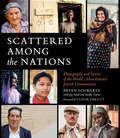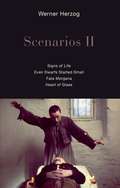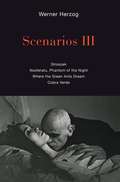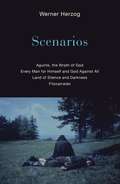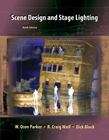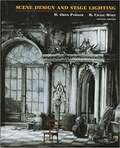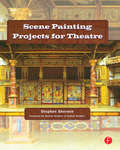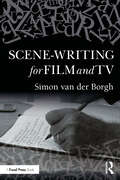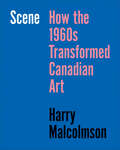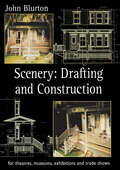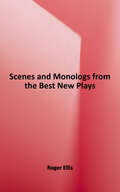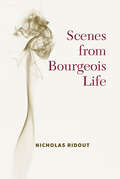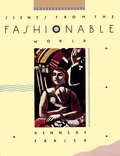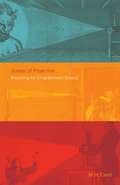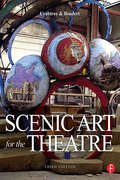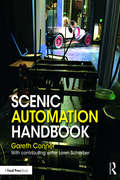- Table View
- List View
Scarborough (Images of America)
by Rodney LaughtonImagine arriving at Scarborough in the late 1800s,stepping out of your train car onto the platform,and becoming one of the many visitors enjoying thesummer beauty of coastal Maine. This pictorial history transports us back to an exciting era in Scarborough's long history--a simpler time, when shore dinner houses and trolley cars were the latest attractions. The images contained in this volume--many of them rare and previously unpublished--feature early automobiles, old homesteads, and summer cottages, as well as unique views of violent shipwrecks and bustling stagecoaches. Through this significant and entertaining collection we experience Prout's Neck the way artist Winslow Homer knew it and everyday life the way that Scarborough photographer Charles F. Walker captured it on film for future generations to marvel at.
Scared of Santa: Scenes of Terror in Toyland
by Denise Joyce Nancy WatkinsHe's huge and hairy and hulking. He dresses in strange furry clothing. He sneaks into people's homes at night.Who wouldn't be afraid of . . . Santa Claus?!?Nothing says Christmas quite like innocent children shrieking with terror as a stranger dressed in red drags them kicking and screaming onto his lap. Now this time-honored rite of passage is celebrated with a hilarious collection of more than two hundred and fifty priceless photos of kids' traumatic trips to Santa's workshop. Scared of Santa offers a cornucopia of photographic funnies—from sixty-year-old family heirlooms to last year's howlers—along with delightful commentary on those unforgettable childhood visits to scary ol' Saint Nick.
Scarf Style 2: Innovative to Traditional, 26 Fresh Designs to Knit
by Ann BuddDiscover fresh new designs for scarves, shawls, and cowls. With Scarf Style 2, you'll follow up to the best-selling Scarf Style and learn from the experts! Scarves are comfort food for knitters, and a great way to learn new techniques without a big investment in time or materials. You'll be introduced to many basic knitting techniques such as color, lace, cables, and more. Whether you are a beginner or more advanced, Scarf Style 2 offers a wide range of patterns for all ages and skill levels. As scarves remain the most popular go-to project for knitters, you'll discover great ways to use small quantities of luxury yarn or use up leftover yarns in your stash. Don't miss the Designer's Notebook at the back that offers further advice on designing your own patterns.
Scarf Style: Innovative To Traditional, 31 Inspirational Styles To Knit And Crochet
by Pam AllenThis collection of 31 elegant and ingenious scarf designs tap the expertise of more than 25 knitwear designers who offer new ways to think about this most basic of garments. Designs by Kathryn Alexander, Debbie Bliss, Nancy Bush, Lily Chin, Nicky Epstein, Sasha Kagan, Sally Melville, and Kristin Nicholas are included, representing a varied exploration of techniques that provide innovative ways to think about knitting and crochet. Sections on knitting and crochet basics, making a scarf without a pattern, and a designer's notebook with templates for basic scarves and suggestions for design variations are provided.
Scarface Nation: The Ultimate Gangster Movie and How It Changed America
by Ken Tucker"Don't get high on your own supply."Brian de Palma's brash, bloody version of Scarface was trashed by critics when it came out twenty-five years ago and didn't do well at the box office, but has become a spectacular fan favorite and enduring pop culture classic since."Never underestimate the greed of the other guy."What makes millions of people obsess over this movie? Why has Al Pacino's Tony Montana become the drug kingpin whose pugnacity and philosophy are revered in boardrooms and bedrooms across America? Who were the people that made the movie, influencing hip-hop style and swagger to this day?"The world is yours."Scarface Nation is Ken Tucker's homage to all things Scarface—from the stars that acted in it to the influence it's had on all of us, from facts, figures and stories about the making of the movie to a witty and comprehensive look at Scarface's traces in today's pop and political culture."Say hello to my li'l fren!"You know you love the line. You know you've seen the movie more than once. Now dive into the ultimate book of Scarface—mounded as high as the pile of cocaine on Tony's desk with delicious details and stimulating observations."You know what capitalism is? F--- you!"
Scarlett's Women: 'Gone With the Wind' and its Female Fans
by Helen TaylorOne of the most successful books ever published and the basis of one of the most popular and highly praised Hollywood films of all time, Gone With the Wind has entered world culture in a way that few other stories have. Seventy-five years on from the cinematic release of Gone with the Wind, Helen Taylor looks at the reasons why the book and film have had such an appeal, especially for women. Drawing on letters and questionnaires from female fans, she brings together material from southern history, literature, film and feminist theory and discusses the themes of the Civil War and issues of race. She has previously written Gender, Race and Region in the writings of Grace King, Ruth McEnery Stuart and Kate Chopin and The Daphne Du Maurier Companion.culture and the reasons why Gone With the Wind maintains a special place in female hearts. 'fascinating . . . an original original' Suzy Feay, Time Out
Scarlett's Women: 'Gone With the Wind' and its Female Fans
by Helen TaylorOne of the most successful books ever published and the basis of one of the most popular and highly praised Hollywood films of all time, Gone With the Wind has entered world culture in a way that few other stories have.Seventy-five years on from the cinematic release of Gone with the Wind, Helen Taylor looks at the reasons why the book and film have had such an appeal, especially for women. Drawing on letters and questionnaires from female fans, she brings together material from southern history, literature, film and feminist theory and discusses the themes of the Civil War and issues of race. She has previously written Gender, Race and Region in the writings of Grace King, Ruth McEnery Stuart and Kate Chopin and The Daphne Du Maurier Companion.
Scars of Sweet Paradise: The Life and Times of Janis Joplin
by Alice EcholsJanis Joplin was the skyrocket chick of the sixties, the woman who broke into the boys' club of rock and out of the stifling good-girl femininity of postwar America. With her incredible wall-of-sound vocals, Joplin was the voice of a generation, and when she OD'd on heroin in October 1970, a generation's dreams crashed and burned with her. Alice Echols pushes past the legary Joplin-the red-hot mama of her own invention-as well as the familiar portrait of the screwed-up star victimized by the era she symbolized, to examine the roots of Joplin's muscianship and explore a generation's experiment with high-risk living and the terrible price it exacted.A deeply affecting biography of one of America's most brilliant and tormented stars, Scars of Sweet Paradise is also a vivid and incisive cultural history of an era that changed the world for us all.
Scatter My Ashes at Bergdorf Goodman
by Bergdorf Goodman Sara James MnookinA gorgeously illustrated companion to the fashion documentary of the same name, Scatter My Ashes at Bergdorf Goodman is an unforgettable collection of anecdotes, from the hilarious to the poignant, in commemoration of the internationally renowned luxury specialty store’s 111th anniversary. With delightful remembrances from celebrities, designers, and highly regarded fashion insiders—from Manolo Blahnik, Marc Jacobs, and Vera Wang to Joan Rivers, Susan Lucci, and Ashley and Mary-Kate Olsen—Scatter My Ashes at Bergdorf Goodman also features a foreword by fashion writer Holly Brubach, as well as art and photography from major advertising campaigns and original vintage sketches created by Bergdorf at the collection presentations of designers such as Lanvin, Chanel, and Balenciaga. This is an essential book for anyone who loves fashion, the thrill of a sumptuous shopping experience, and wonderful stories told by and about the famous.
Scattered Among the Nations: Photographs and Stories of the World's Most Isolated Jewish Communities
by Bryan Schwartz Jay Sand Sandy Carter“A beautifully presented book on Jewish diversity around the world . . . opens windows into lives from the hills of Portugal to the plains of Africa.” —The Jerusalem PostWith vibrant photographs and intricate accounts Scattered Among the Nations tells the story of the world’s most isolated Jewish communities in Africa, Asia, Latin America, the Former Soviet Union and the margins of Europe. Over two thousand years ago, a shipwreck left seven Jewish couples stranded off India’s Konkan Coast, south of Bombay. Those hardy survivors stayed, built a community, and founded one of the fascinating groups described in this book—the Bene Israel of India’s Maharasthra Province. This story is unique, but it is not unusual. We have all heard the phrase “the lost tribes of Israel,” but never has the truth and wonder of the Diaspora been so lovingly and richly illustrated. To create this amazing chronicle of faith and resilience, the authors visited Jews in thirty countries across five continents, hearing origin stories and family histories that stretch back for millennia.“Beautiful, even breathtaking . . . a Jewish (Inter) National Geographic, wisely reminding us that the strategies for survival of Jews in distant lands may be relevant to our own.” —Rabbi Lawrence Kushner, Emanu-El Scholar at Congregation Emanu-El of San Francisco and author of I’m God; You’re Not“This exquisite book is a gift to the Jewish people, dramatically stretching our understanding of ‘Jewish’ . . . A book to be savored, read and re-read, and transmitted from one generation to the next.” —Yossi Klein Halevi, Senior Fellow, Shalom Hartman Institute, Jerusalem
Scenarios II: Signs of Life; Even Dwarfs Started Small; Fata Morgana; Heart of Glass
by Werner HerzogThe second in a series: the master filmmaker&’s prose scenarios for four of his notable filmsOn the first day of editing Fata Morgana, Werner Herzog recalls, his editor said: &“With this kind of material we have to pretend to invent cinema.&” And this, Herzog says, is what he tries to do every day. In this second volume of his scenarios, the peerless filmmaker&’s genius for invention is on clear display. Written in Herzog&’s signature fashion—more prose poem than screenplay, transcribing the vision unfolding before him as if in a dream—the four scenarios here (three never before translated into English) reveal an iconoclastic craftsman at the height of his powers.Along with his template for the film poem Fata Morgana (1971), this volume includes the scenarios for Herzog&’s first two feature films, Signs of Life (1968) and Even Dwarfs Started Small (1970), along with the hypnotic Heart of Glass (1976). In a brief introduction, Herzog describes the circumstances surrounding each scenario, inviting readers into the mysterious process whereby one man&’s vision becomes every viewer&’s waking dream.
Scenarios III: Stroszek; Nosferatu, Phantom of the Night; Where the Green Ants Dream; Cobra Verde
by Werner HerzogFor the first time in English, and in his signature prose poetry, the film scripts of four of Werner Herzog&’s early works &“Herzog doesn&’t write traditional scripts,&” Film International remarked of the master filmmaker&’s Scenarios I and II. &“Instead, he writes scenarios which are like a hybrid of film, fiction, and prose poetry.&”Continuing a series that Publishers Weekly pronounced &“compulsively readable . . . equal parts challenging and satisfying, infuriating and enlightening,&” Scenarios III presents, for the first time in English, the shape-shifting scripts for four of Werner Herzog&’s early films: Stroszek; Nosferatu, Phantom of the Night; Where the Green Ants Dream; and Cobra Verde. We can observe Herzog&’s working vision as each of these scenarios unfolds in a form often dramatically different from the film&’s final version—as, in his own words, Herzog works himself up into &“this kind of frenzy of high-caliber language and concepts and beauty.&”With Scenarios I and II, this volume completes the picture of Herzog&’s earliest work, affording a view of the filmmaker mastering his craft, well on his way to becoming one of the most original, and most celebrated, artists in his field.
Scenarios: Aguirre, the Wrath of God; Every Man for Himself and God Against All; Land of Silence and Darkness; Fitzcarraldo
by Werner HerzogI do not follow ideas, I stumble into stories or into people; and I know that this is so big, I have to make a film. Very often, films come like uninvited guests, like burglars in the middle of the night. They are in your kitchen; something is stirring, you wake up at 3 a.m. and all of a sudden they come wildly swinging at you.When I write a screenplay, I write it as if I have the whole film in front of my eyes. Then it is very easy for me, and I can write very, very fast. It is almost like copying. But of course sometimes I push myself; I read myself into a frenzy of poetry, reading Chinese poets of the eighth and ninth century, reading old Icelandic poetry, reading some of the finest German poets like Hölderlin. All of this has absolutely nothing to do with the idea of my film, but I work myself up into this kind of frenzy of high-caliber language and concepts and beauty.And then sometimes I push myself by playing music, for example, a piano concerto by Beethoven, and I play it and write furiously. But none of this is an answer to the question of how you focus on a single idea for a film. And then, during shooting, you have to depart from it sometimes, while keeping it alive in its essence. —Werner Herzog, on filmmakingWerner Herzog doesn&’t write traditional screenplays. He writes fever dreams brimming with madness, greed, humor, and dark isolation that can shift dramatically during production—and have materialized into extraordinary masterpieces unlike anything in film today. Harnessing his vision and transcendent reality, these four pieces of long-form prose earmark a renowned filmmaker at the dawn of his career.
Scene Design and Stage Lighting
by W. Oren Parker R. Craig Wolf Dick BlockPacked with professional information and cutting-edge technologies, SCENE DESIGN AND STAGE LIGHTING, Ninth Edition, equips you with the most up-to-date coverage available on scenery, lighting, sound, and technology. Completely current, the exciting new ninth edition mirrors the best of real-world practices. Vibrant color production photographs support the text and spotlight examples of contemporary work. Scenery design and technology coverage includes a strong emphasis on modern technology, while changes in the lighting section reflect the latest practices. Coverage of sound for the theatre reflects the digital age in which we live and work. The text also includes an expanded section on television design, as well as greater emphasis on health and safety issues. The authors emphasize collaboration in all sections of the new text, and they provide insight via interviews with professional lighting and scenery designers in two features: "Working Professionals" and "Designers at Work. " Reflecting current professional practice, SCENE DESIGN AND STAGE LIGHTING, Ninth Edition, offers in-depth coverage of a broad range of topics, making it the most detailed and comprehensive text available in the scenic and lighting design and technology fields.
Scene Design and Stage Lighting
by W. Oren Parker R. Craig WolfThis established and respected text for courses in scene design and stage lighting offers a contemporary viewpoint from two experienced authors. The authors highlight current trends, such as the importance of collaboration in the theatrical process.
Scene Painting Projects for Theatre
by Stephen G. SherwinThe art, practice, and technique of scene painting is an essential part of theatre design. A scenic artist is responsible for translating the vision of the scenic designer to the realized scenery.Unlike all other scene painting books, this text will take you step-by-step through actual individual scene painting projects. Each project is commonly used in theatrical productions and each project builds upon the skills learned in the previous lesson. From wood and marble, to foliage and drapery, this book will teach the you how to become a skilled scenic painter.
Scene-writing for Film and TV
by Simon van der BorghFocusing on an integral aspect of screenplays, this book takes students and writers at all levels through the process of understanding and writing better scenes. It interrogates the functions of a scene and how writers can then apply this knowledge to their own film and television scripts. Author Simon van der Borgh familiarises the screenwriter with the fundamental aspects of a scene, looking at what a scene is, the characters involved, the action depicted, dialogue, setting, and style. Featuring original scenes which show the practice of scene-writing and the application of ideas and approaches alongside in-depth analysis and critique, the book explores the process and approach to scene-writing and how to learn and improve methods of telling dynamic, engaging and moving stories of diverse types and formats on screen. With a strong focus on practice-based advice, the book includes exercises at every step to enable writers to build on and extend their knowledge and skills with confidence and clarity chapter by chapter. Exploring the film and TV scene with its different types, forms, and functions, it is the ideal book for aspiring screenwriters and students of screenwriting and filmmaking at all levels, as well as directors, producers and actors looking to better understand the contextual and sub-textual motivations intended by the writer.
Scene: How the 1960s Transformed Canadian Art
by Harry MalcolmsonThe 1960s transformed art in Canada. The Scene traces the remarkable reshaping of the Canadian art landscape during that era. Written by renowned art critic Harry Malcolmson, the book offers a captivating insider’s perspective on how a surge of artists, galleries, collectors, and critics propelled Canadian art into the global spotlight. Malcolmson identifies the catalysts that ignited this artistic renaissance, including an outpouring of pride in the country linked to Canada's Centennial, Expos ’67, and the Toronto City Hall. With rich anecdotes and insights, the book paints a comprehensive portrait of the era, while showcasing over twenty portraits of influential Canadian artists. Richly illustrated, the book illuminates the totality of the Scene’s evolution, and delves into the impact of Canadian nationalism and economic prosperity on the Scene. It examines the rise of contemporary institutions, such as the Art Gallery of Ontario and the National Gallery of Canada, capturing the emergence of a modern Canadian identity. Ultimately, The Scene stands as a unique testament to a pivotal moment in cultural history, capturing the essence of the most impactful decade in the history of art in Canada.
Scenery: Draughting and Construction for Theatres, Museums, Exhibitions and Trade Shows
by John BlurtonThis practical book looks at the types of drawing used, equipment, materials commonly specified, surveying, and also covers building floors, flats, cloths, windows, doors, trucks, staircases, roofs, revolves, multi-story structures, and bridges. By addressing both theater and the commercial world this book will be of real help to a broad range of people in the theater industry.
Scenes and Monologs from the Best New Plays: An Anthology of New Dramatic Writing from Professionally Produced American Plays
by Roger EllisThis book is a practical resource for acting and directing students of all ages middle through high school, college, and professionals young and old. Its 30 duet scenes and eight monologues include a fair sampling of the late 20th-century work of playwrights across the United States. These excerpts are highly original in that few people can claim to have read or seen them performed, though they have all been produced regionally. The gallery of characters contained in these pages offers readers an arresting and kaleidoscopic reflection of American society. The literary styles one encounters here demonstrate the range and power of American writers who will continue to shape theatrical techniques for years to come. Overall, this anthology provides a generous sampling of vital and compelling treatments of our social, artistic, and spiritual experiences of the late 20th century.
Scenes from Bourgeois Life (Theater: Theory/Text/Performance)
by Nicholas RidoutScenes from Bourgeois Life proposes that theatre spectatorship has made a significant contribution to the historical development of a distinctive bourgeois sensibility, characterized by the cultivation of distance. In Nicholas Ridout’s formulation, this distance is produced and maintained at two different scales. First is the distance of the colonial relation, not just in miles between Jamaica and London, but also the social, economic, and psychological distances involved in that relation. The second is the distance of spectatorship, not only of the modern theatregoer as consumer, but the larger and pervasive disposition to observe, comment, and sit in judgment, which becomes characteristic of the bourgeois relation to the rest of the world. This engagingly written study of history, class, and spectatorship offers compelling proof of “why theater matters,” and demonstrates the importance of examining the question historically.
Scenes from the Fashionable World
by Kennedy Fraser"These essays, reprinted from the New Yorker, evince the fastidious prose and finely tuned insights praised in Fraser's first book, The Fashionable Mind. Four pieces emphasize the competition and hype surrounding designers, models, photographers, advertising people, etc.; other articles observe the trendy international scene. Fraser exceeds herself in "As Gorgeous as It Gets," which describes, in glittering detail, cosmetician Estee Lauder and her retinue on travels to promote a new perfume at Nieman-Marcus in Dallas and Saks, Bloomingdale's and Macy's in New York City. This wonderful collection will amaze and amuse readers." --Publisher's Weekly
Scenes of Projection: Recasting the Enlightenment Subject
by Jill H. CasidTheorizing vision and power at the intersections of the histories of psychoanalysis, media, scientific method, and colonization, Scenes of Projection poaches the prized instruments at the heart of the so-called scientific revolution: the projecting telescope, camera obscura, magic lantern, solar microscope, and prism. From the beginnings of what is retrospectively enshrined as the origins of the Enlightenment and in the wake of colonization, the scene of projection has functioned as a contraption for creating a fantasy subject of discarnate vision for the exercise of &“reason.&” Jill H. Casid demonstrates across a range of sites that the scene of projection is neither a static diagram of power nor a fixed architecture but rather a pedagogical setup that operates as an influencing machine of persistent training. Thinking with queer and feminist art projects that take up old devices for casting an image to reorient this apparatus of power that produces its subject, Scenes of Projection offers a set of theses on the possibilities for felt embodiment out of the damaged and difficult pasts that haunt our present.
Scenic Art for the Theatre: History, Tools and Techniques
by Susan Crabtree Peter BeudertNow in its Third Edition, Scenic Art for the Theatre: History, Tools and Techniques continues to be the most trusted source for both student and professional scenic artists. With new information on scenic design using Photoshop, Paint Shop Pro and other digital imaging softwares this test expands to offer the developing artist more step-by-step instuction and more practical techniques for work in the field. It goes beyond detailing job functions and discussing techniques to serve as a trouble-shooting guide for the scenic artist, providing practical advice for everyday solutions.
Scenic Automation Handbook
by Gareth ConnerScenic automation has earned a reputation of being complicated and cantankerous, a craft best left to the elite of our industry. Not sure of the difference between a VFD, PLC, or PID? If you have dreamed of choreographing scene changes with computerized machinery, but get lost in the technical jargon the Scenic Automation Handbook will guide you along the road to elegant automation. Adopting a pragmatic approach, this book breaks down any automation system into five points, known as the Pentagon of Power. Breaking down a dauntingly complex system into bite- size pieces makes it easy to understand how components function, connect, and communicate to form a complete system. Presenting the fundamental behaviors and functions of Machinery, Feedback Sensors, Amplifiers, Controls, and Operator Interfaces, the Scenic Automation Handbook demystifies automation, reinforcing each concept with practical examples that can be used for experimentation. Automation is accessible – come along and learn how!


